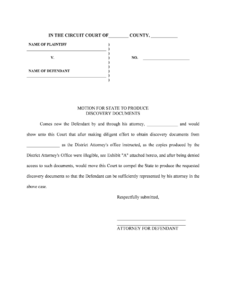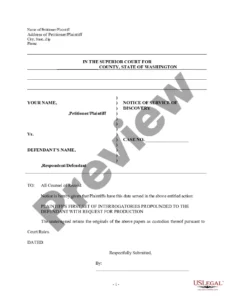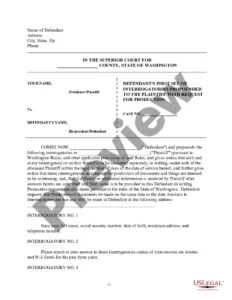Utilizing such a standardized document offers several advantages. It reduces the time and expense associated with discovery by obtaining clear and concise admissions on key factual points. This can help focus the litigation on genuinely contested issues, minimizing the need for extensive depositions or interrogatories. Furthermore, these admissions can serve as compelling evidence at trial, strengthening a party’s position and potentially facilitating settlement negotiations.
This article will further explore the specific requirements and procedures involved in using these crucial documents in Florida, including best practices for drafting, serving, and responding to them, as well as addressing common challenges and potential pitfalls.
Key Components of a Florida Request for Admissions
A well-drafted request for admissions in Florida incorporates several crucial elements to ensure clarity, enforceability, and effectiveness in the discovery process. These components contribute to a streamlined and efficient resolution of factual disputes.
1. Case Caption: Accurate case information, including the court, case number, and parties’ names, is essential for proper identification and filing.
2. Introductory Statement: A brief, formal introduction sets the context and purpose of the document, clearly identifying it as a request for admissions.
3. Numbered Requests: Each request should be individually numbered and presented as a clear, concise, and unambiguous statement. Compound or complex requests should be avoided to prevent confusion and ensure straightforward responses.
4. Specific and Relevant Facts: Requests should focus on specific, relevant facts directly related to the claims or defenses in the case. The aim is to establish undisputed facts, narrowing the scope of the litigation.
5. Instructions for Responding: Clear instructions on how to respond, including deadlines and permissible responses (admit, deny, or object), must be provided. This ensures compliance with procedural rules and facilitates a timely response.
6. Signature and Certification: The requesting attorney’s signature and certification, as required by Florida rules of procedure, are essential for the document’s validity. This certifies the legitimacy and good faith basis of the requests.
7. Definitions and Instructions: Including a section defining key terms and providing specific instructions for responding, such as how to address objections or inability to admit or deny, enhances clarity and minimizes potential disputes over interpretations.
Adherence to these components ensures that the request complies with Florida legal requirements, maximizes its effectiveness in obtaining admissions, and contributes to a more efficient and focused litigation process. Properly structured requests help clarify the issues in dispute and facilitate a just resolution.
How to Create a Florida Request for Admissions
Creating a comprehensive and effective request for admissions in Florida requires careful attention to detail and adherence to specific procedural rules. The following steps outline the process of drafting a compliant and impactful document.
1. Consult Florida Rules of Civil Procedure: Begin by thoroughly reviewing the applicable Florida Rules of Civil Procedure governing requests for admissions. This ensures compliance with all legal requirements and formatting guidelines.
2. Accurate Case Caption: Ensure the document includes the correct case caption information, including the court, case number, and the full and accurate names of all parties involved in the litigation.
3. Draft Clear and Concise Requests: Formulate each request as a clear, concise, and unambiguous statement of fact. Avoid compound or complex questions, focusing on singular, readily verifiable points. Each request should be numbered for clarity and ease of reference.
4. Maintain Relevance and Specificity: Every request must be directly relevant to the claims or defenses asserted in the case. Focus on essential facts that, if admitted, will streamline the litigation and potentially resolve key issues.
5. Include Clear Instructions for Responding: Provide explicit instructions for responding, including the deadline for response and the permissible options (admit, deny, object, or explain inability to admit or deny). Cite the relevant rules of procedure governing these responses.
6. Proper Signature and Certification: The drafting attorney must sign and certify the document in accordance with Florida Rules of Civil Procedure. This affirms the legitimacy and good-faith basis of the requests.
7. Organize Logically and Professionally: Present the requests in a logical and organized manner, using clear formatting and numbering. This enhances readability and ensures that the document is easily understood by the opposing party and the court.
8. Review and Revise: Before serving the request, carefully review and revise the document for accuracy, clarity, and completeness. Ensure compliance with all applicable rules and strategic objectives.
By adhering to these steps and maintaining a focus on clarity, relevance, and compliance with procedural rules, legal professionals can craft effective requests for admissions that contribute to a more efficient and focused litigation process in Florida.
Strategic use of standardized documents for obtaining admissions of fact represents a crucial aspect of efficient and effective litigation in Florida. Understanding the components, creation process, and legal ramifications of these requests allows legal professionals to leverage this powerful tool to streamline discovery, narrow the scope of disputes, and facilitate more focused and cost-effective resolutions. Adherence to Florida’s procedural rules, coupled with careful drafting and strategic implementation, maximizes the impact of these requests, contributing to a more just and efficient legal process.
Proper utilization of these requests not only benefits individual litigants but also contributes to the overall efficiency of the Florida court system. By encouraging the early resolution of undisputed factual matters, these tools promote judicial economy and allow courts to focus on the core contested issues of each case. The ongoing refinement of legal practice through consistent and accurate application of these procedures remains essential for achieving just and timely outcomes in the pursuit of justice.


